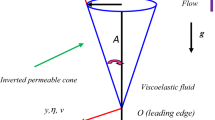Abstract
The effects of thermal entrance length, polymer degradation and solvent chemistry were found to be critically important in the determination of the drag and heat transfer behavior of viscoelastic fluids in turbulent pipe flow.
The minimum heat transfer asymptotic values in the thermally developing and in the fully developed regions were experimentally determined for relatively high concentration solutions of heat transfer resulting in the following correlations:
For dilute polymer solutions the heat transfer is a function ofx/d, the Reynolds number and the polymer concentration.
The Reynolds analogy between momentum and heat transfer which has been widely used in the literature for Newtonian fluids is found not to apply in the case of drag-reducing viscoelastic fluids.
Zusammenfassung
Der Einfluß der thermischen Einlauflänge, die polymere Zersetzung und die Lösungsmittelchemie wurden als wichtige Einflußgrößen bei der Bestimmung des Widerstandes und Wärmeüberganges bei turbulenter Rohrströmung von viskoelastischen Fluiden erkannt.
Für Lösungen mit relativ hoher Konzentration wurden die minimalen asymptotischen Wärmeübergangszahlen in der thermischen Einlaufstrecke und der voll ausgebildeten Strömung experimentell ermittelt. Folgende Gleichungen beschreiben den Wärmeübergang:
Bei verdünnten Polymerlösungen ist der Wärmeübergang eine Funktion vonx/d, der Re-Zahl und der Polymerkonzentration. Die Reynolds-Analogie zwischen Impuls- und Wärmetransport, die in der Literatur häufig auf Newtonsche Fluide angewendet wird, ist nicht anwendbar bei widerstandsreduzierenden, viskoelastischen Fluiden.
Similar content being viewed by others
Abbreviations
- c :
-
concentration (wppm)
- d :
-
tube diameter (cm)
- De:
-
Deborah number
- h :
-
convective heat transfer coefficient (w/m2‡C)
- jH :
-
heat transferj factor, StPr2/3
- k :
-
thermal conductivity of fluid (w/m ‡C)
- K′, n :
-
power-law constant in Τw=K′ (8V/d) n
- l :
-
total tube length (cm)
- Nu:
-
Nusselt number,h d/K
- Pra :
-
Prandtl number based on the viscosity at wall,η C p/K
- Rea :
-
Reynolds number based on the viscosity at wall,ϱ Vd/η
- Re′:
-
Reynolds number defined asV 2−n dn/(K′ 8n−n)
- St:
-
Stanton number, Nu/(Rea Pra)
- T b :
-
bulk temperature of fluid
- T w :
-
inside wall temperature
- ¯T :
-
characteristic time of the flow
- V :
-
average velocity
- x :
-
axial distance (cm)
- \(\dot \gamma \) :
-
shear rate (l/sec)
- η :
-
apparent viscosity evaluated at wall (poise)
- ϱ :
-
density of fluid (g/cm3)
- Τ w :
-
wall shear stress (dyne/cm2)
- λ :
-
characteristic time of fluid
- %DR:
-
percentage drag reduction defined as (fNewtonian f)/fNewtonian
- %HTR:
-
percentage heat transfer reduction defined as (j H,Newtonian-j)/j H.Newtonian
- exit:
-
data collected at the tube exit
References
Toms, B. A.: Some Observations on the Flow of Linear Polymer Solutions through Straight Tubes at Large Reynolds Numbers. Proc. Int. Congr. on Rheology 2 (1949) 135
Mysels, K. J.: Flow of Thickened Fluids. U.S. Patent No. 2,492,173 (1949) and Early Experiences with Viscous Drag Reduction. Chem. Eng. Prog. Symp. Ser. 67 (1971) 45
Tung, T. T., Ng, K. S.; Hartenett, J. P.: Influence of Rheological Property Changes on Friction and Convective Heat Transfer in a Viscoelastic Polyacrylamide Solution. Toronto: Sixth Int'l Heat Transfer Conf. 1978
Yoo, S. S.: Ph. D. Thesis, Heat Transfer and Friction Factors for Non-Newtonian Fluids in Turbulent Pipe Flow. University of Illinois at Chicago Circle 1974
Marrucci, G; Astarita, G.: Turbulent Heat Transfer in Viscoelastic Liquids. Ind. Eng. Chem. Fundam. 6 (1967) 470
Pruitt, G. T.; Whitsitt, N. F.; Crawford, H. R.: Turbulent Heat Transfer to Viscoelastic Fluids. The Western Company, Contract No. NA7-369, 1966
Wells, C. S., Jr.: Turbulent Heat Transfer in Drag Reducing Fluids. AIChE J. 14 (1968) 406
Corman, J. C.: Exoerimental Study of Heat Transfer to Viscoelastic Fluids. Ind. Eng. Chem. Process, Des. Dev. 2 (1970) 254
Poreh, M.; Paz, U.: Turbulent Heat Transfer to Dilute Polymer Solutions. Int. J. Heat Mass Transfer 11 (1968) 805
Mizushina, T.; Usui, H.: Reduction of Eddy Diffusion for Momentum and Heat in Viscoelastic Fluid Flow in a Circular Tube. Phy. Fluids 20 (1977) S 100
Ibele, W.: Thermophysical Properties. Handbook of Heat Transfer (ed. Rohsenow, W. M.; Hartnett, J. P.). New York: McGraw-Hill 1973
Gupta, M. K.; Metzner, A. B.; Hartnett, J. P.: Turbulent Heat Transfer Characteristics of Viscoelastic Fluids. Int. J. Heat Mass Transfer 10 (1967) 1211
Khabakhpasheva, M. E.; Popov, V. I.; Perepelitsa, B. V.: Heat Transfer in Viscoelastic Fluids in Heat Transfer. Vol. IV, Fourth Int. Heat Transfer Conf, Paris-Versailles, p. Rh 2, 1970
Monti, R.: Heat Transfer in Drag-Reducing Solutions (ed. Schowalter, W. R.; Minkowycz, W. J.; Luikov, A. V.; Afgan, N. H.;). Prog, in Heat and Mass Transfer 5 (1972) 239
Ng, K. S.; Cho, Y. I.; Hartnett, J. P.: Heat Transfer Performance of Concentrated Polyethylene Oxide and Polyacrylamide Solutions. AIChE Symp. Ser. 76 (1980) 250
Chiou, C. S.; Gordon, R. J.: Low Shear Viscosity of Dilute Polymer Conformation on Turbulent Drag Reduction. AIChE J. 26 (1980) 852
White, D., Jr.; Gordon, R. J.: The Influence of Polymer Conformation on Turbulent Drag Reduction. AIChE J. 21 (1975) 1027
Kwack, E. Y.; Hartnett, J. P.; Cho, Y. I.: Chemical Effects in the flow of Dilute Polymer Solutions. Letters Heat Mass Transfer 7 (1980) 1
Bird, R. B.: Zur Theorie des Wärmeübergangs an nicht-Newtonsche Flüssigkeiten bei laminarer Rohrströmung. Chem.-Ing.-Teck. 31 (1959) 569
Cho, Y. I.; Ng, K. S.; Hartnett, J. P.: Viscoelastic Fluids in Turbulent Pipe Flow — a new Heat Transfer Correlation. Lett. Heat Mass Transfer 7 (1980) 347
Virk, P. S.; Mickley, H. S.; Smith, K. A.: The Ultimate Asymptote and Mean Flow Structure in Toms' Phenomenon. Trans. ASME J. Appl. Mech. 37 (1970) 488
Author information
Authors and Affiliations
Additional information
Dedicated to Prof. Grigull on his 70th Birthday.
Rights and permissions
About this article
Cite this article
Kwack, E.Y., Hartnett, J.P. & Cho, Y.I. Turbulent heat transfer in circular tube flows of viscoelastic fluids. Wärme- und Stoffubertragung 16, 35–44 (1982). https://doi.org/10.1007/BF01322804
Received:
Issue Date:
DOI: https://doi.org/10.1007/BF01322804




